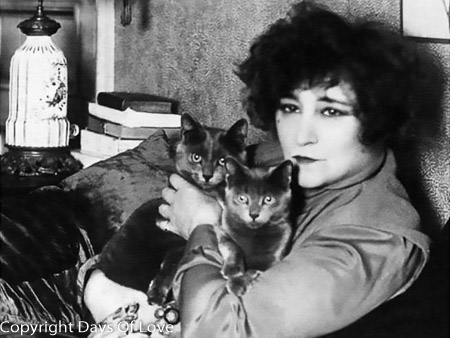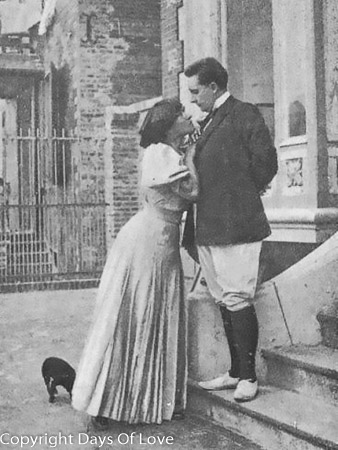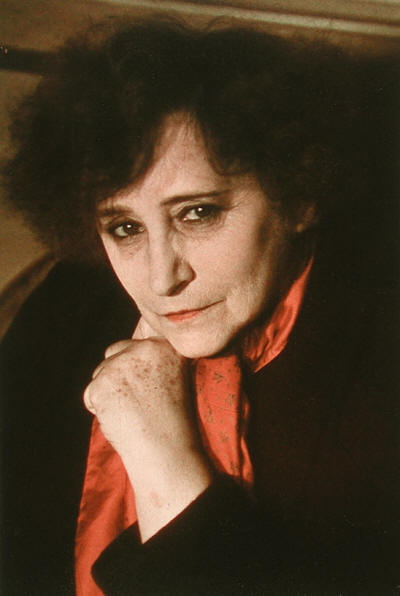

Husband Henry Gauthier-Villars, Partner Georgie Raoul-Duval, Mathilde de Morny, Marquise de Belbeuf
Queer Places:
8-10 rue Colette, 89520 Saint-Sauveur en Puisaye,
France
9 Rue de l'Égalité, 45230 Châtillon-Coligny, France
55 Quai des Grands Augustins, 75006 Paris, France
28 Rue Jacob, 75006 Paris, France
7 Rue Pierre Laplace, 25000 Besançon, France
44 rue de Villejust, Rue Paul Valéry, 75116 Paris, France
25 Rue de Saint-Sénoch, 75017 Paris, France
Rozven, Roz Ven, 35350 Saint-Coulomb, France
57 Rue Cortambert, 75116 Paris,
France
Château de Castel Novel, Cst Novel, 19240 Varetz, France
69 Bd Suchet, 75016 Paris, France
9 Rue de Beaujolais, 75001 Paris, France
Chem. de l'Estagnet, 83990 Saint-Tropez, France
Villa Belle Plage, Rue du Capitaine Guy Dath, 80550 Le Crotoy, France
Hôtel Claridge Paris, 37 Rue François 1er, 75008 Paris, France
Père Lachaise Cemetery, 16 Rue du Repos, 75020 Paris, France
 Colette
(Sidonie-Gabrielle Colette, 28 January 1873 – 3 August 1954) was a French
novelist nominated for the Nobel Prize in Literature in 1948.[1]
Her best known work, the novella Gigi (1944), was the basis for the
film and Lerner and Loewe stage production of the same name. She was also a
mime, an actress, and a journalist. She was in a relationship with Missy de
Morny; during this time Colette cropped her hair, wore English ties, and
sported a bracelet engraved with the phrase, "I belong to Missy." Her first
lesbian lover, Georgie
Raoul-Duval, would later be the model for the mother in
Jean Cocteau’s novel Les Parents
terribles.
Natalie Clifford Barney
enigmatically listed Colette as a ‘half’, rather than a ‘full’, conquest. But
the most significant and lasting of Colette’s lesbian relationships was with
Sophie-Mathilde-Adèle-Denise de
Morny, marquise de Belboeuf, otherwise known as ‘Missy’. An inspiration to
men as well as women, Missy was the model for the title character in
Rachilde’s Marquise de Sade and the
protagonist of Jean Lorrain’s Âme
de boue.
Colette
(Sidonie-Gabrielle Colette, 28 January 1873 – 3 August 1954) was a French
novelist nominated for the Nobel Prize in Literature in 1948.[1]
Her best known work, the novella Gigi (1944), was the basis for the
film and Lerner and Loewe stage production of the same name. She was also a
mime, an actress, and a journalist. She was in a relationship with Missy de
Morny; during this time Colette cropped her hair, wore English ties, and
sported a bracelet engraved with the phrase, "I belong to Missy." Her first
lesbian lover, Georgie
Raoul-Duval, would later be the model for the mother in
Jean Cocteau’s novel Les Parents
terribles.
Natalie Clifford Barney
enigmatically listed Colette as a ‘half’, rather than a ‘full’, conquest. But
the most significant and lasting of Colette’s lesbian relationships was with
Sophie-Mathilde-Adèle-Denise de
Morny, marquise de Belboeuf, otherwise known as ‘Missy’. An inspiration to
men as well as women, Missy was the model for the title character in
Rachilde’s Marquise de Sade and the
protagonist of Jean Lorrain’s Âme
de boue.
Colette, who signed her letters to Natalie Clifford Barney with significant phrases – ‘I kiss you as skilfully as I know how’ – found in the coteries of lesbian Paris a writer’s dream of instant, profound communication: I enjoyed that wonderful promptness in silent language, in the exchange of threats and promises, as if, once dull-witted males were out of the way, every message from one woman to another became as clear as a flash of lightning, reduced as it was to a small number of infallible signs.
Historical homosocial and homosexual communities of expatriate American and English women lived in Paris on the Left Bank of the Seine during the opening decades of the twentieth century. The place and time has captured the imaginations of feminist and queer historians, literary critics, art historians, and cultural theorists. These histories of women and their cultural productions are attractive because they demand a rethinking and rewriting of the canonical histories of masculine modernism. The geographical and spiritual locus for these groups were the literary and artistic salons of Natalie Barney and Gertrude Stein, as well as the bookshops and publishing houses owned by Sylvia Beach and Adrienne Monnier. Congregating at these cultural landmarks, Janet Flanner, Colette, Renée Vivien, Djuna Barnes, Hilda Doolittle, Claude Cahun, Marcel Moore (Suzanne Malherbe), Anaïs Nin, and many others invented new ways of living and representing themselves and each other. Martha Vicinus writes: The most striking aspect of the lesbian coteries of the 1910s and 1920s was their self-conscious effort to create a new sexual language for themselves that included not only words but also gestures, costume and behavior. Lillian Faderman notes that these Parisian communities “functioned as a support group for lesbians to permit them to create a self-image which literature and society denied them.”

Colette and Missy de Morny

Colette, 1939, by Gisèle Freund
Sidonie-Gabrielle Colette was born on January 28, 1873, to war hero and tax collector Jules-Joseph Colette and his wife Adèle Eugénie Sidonie ("Sido"), née Landoy, in the village of Saint-Sauveur-en-Puisaye in the département of Yonne, Burgundy. The family was initially well off, but by the time she was of school age poor financial management had substantially reduced her father's income and she attended a public school from the ages of 6 to 17 — this was, nevertheless, a fairly extensive education for a girl of the period.[2][3]
In 1893 she married Henry Gauthier-Villars (1859–1931) or "Willy", his nom-de-plume,[4] a well-known author and publisher, and her first four novels — the four Claudine stories, Claudine à l'école (1900), Claudine à Paris (1901), Claudine en ménage (1902), and Claudine s'en va (1903) — appeared under his name. They chart the coming of age of their heroine, Claudine, from an unconventional fifteen-year-old in a Burgundian village to the literary salons of turn-of-the-century Paris. (The four are published in English as Claudine at School, Claudine in Paris, Claudine Married, and Claudine and Annie). The story they tell is semi-autobiographical, but not entirely — most strikingly, Claudine, unlike Colette, is motherless.[5][6]
Willy, fourteen years older than his wife and one of the most notorious libertines in Paris, introduced Colette into avant-garde intellectual and artistic circles while engaging in sexual affairs and encouraging her own lesbian alliances. It was he who chose the titillating subject-matter of the Claudine novels, "the secondary myth of Sappho... the girls' school or convent ruled by a seductive female teacher" (Ladimer, p. 53). Colette later said that she would never have become a writer if it had not been for Willy.[7][8] Nevertheless, when Colette wished to have her name associated with her work as it became widely known, Willy resisted and "locked her in her room until she produced enough pages to suit him."[9]
Colette and Willy separated in 1906, although it was not until 1910 that the divorce became final. She had no access to the sizable earnings of the Claudine books — the copyright belonged to Willy — and until 1912 she followed a stage career in music halls across France, sometimes playing Claudine in sketches from her own novels, earning barely enough to survive and often hungry and unwell. This period of her life is recalled in La Vagabonde (1910), which deals with women's independence in a male society, a theme to which she would regularly return in future works. During these years she embarked on a series of relationships with other women, notably with Mathilde de Morny, Marquise de Belbeuf ("Missy"), with whom she sometimes shared the stage. On January 3, 1907, an onstage kiss between Missy and Colette in a pantomime entitled Rêve d'Égypte caused a near-riot, and as a result they were no longer able to live together openly, although their relationship continued for another five years.[10][11][12]
time’. In Claudine à l’école (1900) and the sequel, Claudine en ménage (1902), Colette showed that a witty, intelligent young woman could enjoy normal lesbian relations without becoming a mindless victim or a predatory fiend.
In 1912 Colette married Henry de Jouvenel, the editor of Le Matin. A daughter, Colette de Jouvenel, nicknamed Bel-Gazou, was born in 1913. During the war she devoted herself to journalism, but marriage allowed her to devote her time to writing.[10][13][14] When Colette came to realise that her own daughter, Bel-Gazou, was having relationships with other women, she was strongly disapproving.
In 1920 Colette published Chéri, portraying love between an older woman and a much younger man. Chéri is the lover of Léa, a wealthy courtesan; Léa is devastated when Chéri marries a girl his own age, and delighted when he returns to her, but after one final night together she sends him away again.[15]
The marriage to Jouvenel ended in divorce in 1924, partly due to Jouvenel's infidelities and partly to Colette's own affair with her sixteen-year-old stepson, Bertrand de Jouvenel. In 1925 she met Maurice Goudeket, who became her final husband (the couple stayed together until her death).[10][13]
Already an established writer (The Vagabond had received three votes for the prestigious Prix Goncourt), the decades of the 1920s and 1930s were Colette's most productive and innovative period.[16] Set mostly in Burgundy or Paris during the Belle Époque, her work treated married life and sexuality. It was frequently quasi-autobiographical: Chéri (1920) and Le Blé en herbe (1923) both deal with love between an aging woman and a very young man, a situation reflecting her relationship with Bertrand de Jouvenel and even Goudeket, who was sixteen years her junior.[13][10] La Naissance du Jour (1928) is her explicit criticism of the conventional lives of women, expressed in a meditation on age and the renunciation of love through the character of her mother, Sido.[17]
By this period Colette was frequently acclaimed as France's greatest woman writer. "It... has no plot, and yet tells of three lives all that should be known", wrote Janet Flanner of Sido. "Once again, and at greater length than usual, she has been hailed for her genius, humanities and perfect prose by those literary journals which years ago... lifted nothing at all in her direction except the finger of scorn."[18]
Colette, who moved in the same social circles as Coco Chanel, provided a whimsical description of Chanel at work in her atelier, which appeared in Prisons et Paradis (1932). "If every human face bears a resemblance to some animal, then Mademoiselle Chanel is a small black bull. That tuft of curly black hair, the attribute of bull-calves, falls over her brow all the way to the eyelids and dances with every maneuver of her head."[9]:248
Always in 1932, Germaine Krull took a photographic portrait of Colette.
Colette was 67 years old at the fall of France, and remained in Paris, in her apartment in the Palais Royal. Her husband Maurice Goudeket, who was Jewish, was arrested by the Gestapo in December 1941, and although he was released after a few months through the intervention of the French wife of the German ambassador, Colette lived through the rest of the war years with the anxiety of a possible second arrest.[19][20] During the Occupation she produced two volumes of memoirs, Journal à rebours (1941) and De ma fenêtre (1942 — the two issued in English in 1975 as Looking Backwards).[10]
In 1944 she published what became perhaps her most famous work, Gigi, telling the story of sixteen year old Gilberte ("Gigi") Alvar. Born into a family of demimondaines, Gigi is being trained as a courtesan to captivate a wealthy lover, but breaks with tradition by marrying him instead.[21] In 1949 it was made into a French film starring Danièle Delorme and Gaby Morlay, then in 1951 adapted for the stage with the then-unknown Audrey Hepburn in the title role, picked by Colette personally; the 1958 Hollywood musical, starring Leslie Caron and Louis Jourdan, with a screenplay by Alan Jay Lerner and a score by Lerner and Frederick Loewe, won the Academy Award for Best Picture.
In the postwar years, she became a famous public figure, crippled by arthritis and cared for by Goudeket, who supervised the preparation of her collected works, or Œuvres complètes (1948–1950). She continued to write during these years, bringing out L'Etoile vesper (1944) and Le Fanal bleu (1949), in which she reflected on the problems of a writer whose inspiration is primarily autobiographical. On her death on August 3, 1954, she was refused a religious funeral by the Catholic Church on account of her divorces, but was given a state funeral, the first French woman of letters to be granted this honour, and interred in Père-Lachaise cemetery.[19][20][10][22]
She is also connected with Sonia Delaunay.
My published books: